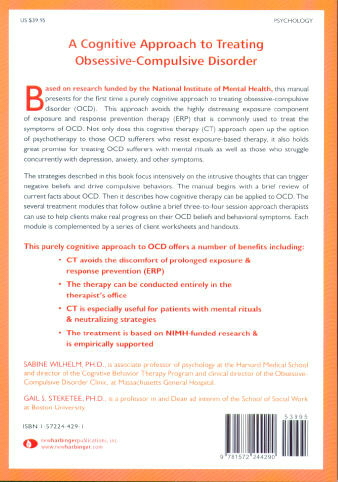Cognitive Therapy for Obsessive Compulsive Disorder
By
Sabine Wilhelm, Ph.D.;
Gail S. Steketee, Ph.D.
Course Description
Based on research funded by the National Institute of Mental Health, this manual presents for the first time a purely cognitive approach to treating obsessive-compulsive disorder (OCD). This approach avoids the highly distressing exposure component of exposure and response prevention therapy (ERP) that is commonly used to treat the symptoms of OCD. Not only does this cognitive therapy (CT) approach open up the option of psychotherapy to those OCD sufferers who resist exposure-based therapy, it also holds great promise for treating (OCD) sufferers with mental rituals as well as those who struggle concurrently with depression, anxiety, and other symptoms.
The strategies described in this book focus intensively on the intrusive thoughts that can trigger negative beliefs and drive compulsive behaviors. The manual begins with a brief review of current facts about OCD. Then it describes how cognitive therapy can be applied to OCD. The several treatment modules that follow outline a brief three-to-four session approach therapists can use to help clients make real progress on their OCD beliefs and behavioral symptoms. Each module is complemented by a series of client worksheets and handouts.
This purely cognitive approach to OCD offers a number of benefits including:
- CT avoids the discomfort of prolonged exposure and response prevention (ERP)
- The therapy can be conducted entirely in the therapist’s office
- CT is especially useful for patients with mental rituals and neutralizing strategies
- The treatment is based on NIMH-funded research and is empirically supported
About the Authors
Sabine Wilhelm, Ph.D., is associate professor of psychology at the Harvard Medical School and director of the Cognitive Behavior Therapy Program and clinical director of the Obsessive-Compulsive Disorder Clinic, at Massachusetts General Hospital.
Gail S. Steketee, Ph.D., is a professor in and Dean ad interim of the School of Social Work at Boston University.
Learning Objectives
- Define the concept of neutralizing thoughts and behavior.
- State the three symptoms listed when OCD is diagnosed.
- List the 5 subtypes of OCD.
- State the most common onset of age for OCD.
- List the 2 main other diagnosable psychiatric problems of people with OCD.
- State the individual credited with the development of the cognitive theory.
- Describe thought-action fusion according to Rachman (1993).
- Describe the early findings on which behavioral treatment is based.
- State the major goal in exposure and response prevention.
- Describe the results of combining cognitive methods and exposure techniques.
- List the therapeutic effects of cognitive therapy.
- Define repugnant obsessions.
- Describe the Obsessive Compulsive Symptoms Rating Scale.
- List the two preliminary steps prior to treatment.
- Describe when relapse prevention is addressed during therapy.
- Define Socratic questioning (Beck 1995).
- Describe the continuum technique (Beck 1995).
- Describe the “Fill in the Blanks” strategy (Freestone et al. 1996).
- List a goal that needs to be established at the first meeting.
- State the form that is consistently used in session 2, 3, and 4.
- Describe the Seven-Column Thought Record.
- Define thought-action fusion.
- Describe the continuum scale and include the initial ratings.
- State an alternative to evaluating your patients intrusions /obsessions.
- State why metaphors and analogies are good teaching tools.
- State why OCD is called the “doubting disease.”
- State which technique is useful for patients who want certainty of their sexual orientation.
- Describe the pie chart technique.
- Describe the double-standard technique.
- List the 4 common errors related to perfectionistic standards.
- List common beliefs that are identified with the downward arrow technique.
- State why behavioral experiments are useful.
- State two examples of a core belief.
- List two other terms used to describe core beliefs.
- State the most common method of helping patients challenge core beliefs.
- Describe the last two sessions of therapy.
- Define lapse.
- Describe the Self-Coaching Session Form.
Course Contents
- Cognitive Features, Theories, and Treatments for OCD
- Structure and Application of Cognitive Therapy
- Summary of Cognitive Therapy Techniques
- Assessment and Education
- Over importance of Thoughts
- Control of Thoughts
- Overestimation of Danger
- Desire for Certainty
- Responsibility
- Perfectionism
- Consequences of Anxiety
- Fear of Positive Experiences
- Modifying Core Beliefs
- Relapse Prevention


